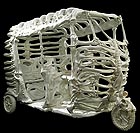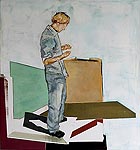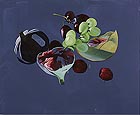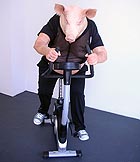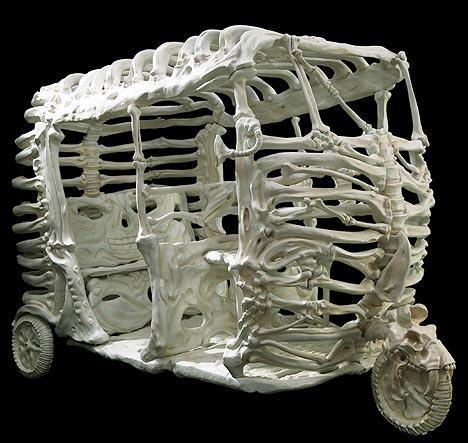
translated and summarized by: Liz Wollner-Grandville,
English summary September 21 - 27
Essl Museum: Chalo! India
Ghandi’s fingers
Despite announcements to the contrary there is no end to the current India-Hype: in the next couple of years, after exhibits in the Serpentine Gallery and the Kunsthaus Bern, the Centre Pompidou and the LACMA are also presenting art from India. In Austria, the Essl Museum is once again the pioneer - similar to the exhibitions of the Leipziger School and Chinese art: currently a grand exhibition of art from India is being shown.
The discussion around these kinds of exhibitions always focuses on what would be “typical” for a certain region of the world; not completely free of clichés, the search for the allegedly cultural specific characteristics begins.
At the Essl Museum – the exhibition was partly taken from the Mori Art Museum in Tokyo – one at first embraces the stereotype ideas: the exhibition-poster, a satirical self-dramatisation of Pushpamala N., the sperm-covered, exhausted elephant by Barti Kher, the abstract, gleaming circle of thousands of bindis (forehead decoration) and the walk-in shrines by Gulammodhammed Sheikh, who celebrates the subcontinent’s cultural hybridisation with figures from different religions, based on the Middle Age Mappa Mundi.
But the cultural attributions are predominantly handled with more scepticism – except for Jagannth Panda’s magnificent peacock, who alludes to India’s “national bird”. On Ashim Purkayastha’ stamps, Mahatma Ghandi shows his middle finger, Pushpamala N. poses as the grinning Goddess of Lakshmi, and Tushar Joag’s memorial reproduction is positioned in Mumbai at the most unsuitable place one can think of.
Others develop urban utopias, construct car-rickshaws made of artificial bones, and Indian bridal couples amalgamate with European-American icons of art and film history. The fact that the works were arranged according to specific topics can be seen as a measure against otherwise absolute arbitrariness. Nevertheless, on account of the pluralism of its positions, the exhibition remains to be a bit vague – but this is possibly not the worst approach when offering the “first overview” of an, in Europe, widely unknown artistic territory.
By Nina Schedlmayer
Essl Museum
3400 Klosterneuburg, an der Donau-Au 1, until 01.11.09
www.essl.museum
MAK: Meiji. Japan around 1900
Undisclosed
The Japanese word “Meiji” means “Enlightened Rule”. This was the motto under which the then only 16-year old Emperor Mutsuhito succeeded the throne in 1868 and under which he opened his country to western influence, Japan emerged into one of the great powers in the world.
The MAK presents art works from the Meiji-era, which partly stem from its own inventory, dating back to the 1973 Vienna World Expo, but the majority are parts of private Japanese collections. Among them are both noble as well as bizarre works of art: a top-cupboard made of black lacquer with landscapes, birds and flowers in gold lacquer, a food bowl depicting a river landscape, a wooden writing casket with a gold and silver lacquered relief on a gold background, and a cassette with wooden inlaying – they all correspond to the plain elegance, which one commonly associates with Japan.
Extravagant and grotesque in comparison: the stoneware vases, with jolly frogs bustling around; the vase resembling an elephant, or clay teapots, so crudely manufactured that one still sees the fingerprints, including bizarre little animals.
One would like to know more about these objects, but there is not much more available than the technical data. Altogether, the presentation subverts the quality of the exhibition: upon entering the space it is not clear where the show begins and where it ends. Some of the large vases are displayed in such an awkward way, that a closer look at them is impossible; and the explanatory text simply states that the comparison between the “official” objects (those presented by the state of Japan at the World Expo), and those from private collections “is insightful” – there is a total lack of more detailed information or an adequate spatial presentation. What remains is an exhibition with fine, exciting, unusual, and noble pieces – and an insufficient disclosure
By Nina Schedlmayer
MAK-Applied Arts/Contemporary Art
1010 Vienna, Stubenring 5, until 04.10.09
www.mak.at
Galerie Gerersdorfer: Berliner Luft – Bianca Regl. Robert Muntean
Fascinating comparison
They could not be more different, the paintings by the two Viennese artists who both live in Berlin. One of them subjective, painting expressively in a subtly reserved manner as in the large-format painting “sub-rosa-2”, the other one brash and bright, citing fragments of our modern everyday life, such as the sticky-sweet and artificial tasting gum cherries on huge canvases.
Both of them paint, paint with oil on canvas, paint - among other things - people, yet the impressions these paintings leave is profoundly different. Lonely and withdrawn figures, dancing by themselves, in pastel colours, partially blurred and jotted down by Robert Muntean. His new, nearly abstract works such as “tremens” (2009), present an interesting new facet of the young artist. Bianca Regl, in comparison, always paints by the same formula on a strictly monochrome grounded canvas. Despite her accuracy of every detail of people and even more so of fruits and flowers, these paintings have nothing individual, but rather the stereotype ideal image of a raspberry or a young woman, like in the oil painting “Portrait 1”. By playing expertly with omissions and incomplete sections that have no effect on the meaning, these works prove how this artist works according to a formula. Yet her paintings of meat, depicting abstract, misshapen pieces of meat, are different. It becomes apparent that the artist had to paint her individual way to the object, as there are no suitable well-known works on similar topics available. And it is these kinds of paintings, which are barely recognizable as figurative, are the most impressive in the exhibition.
By Wolfgang Pichler
1090 Vienna, Währinger Strasse 12, until 17.10.09
www.gerersdorfer.at
Galerie Steinek: Deborah Sengl – All you can lose
Nothing to lose?
Since Deborah Sengl’s satirical paintings have always mirrored the beast in us - and rarely in a flattering way - it comes as no surprise that she satirizes the fitness-craze in her current exhibit. She depicts humans with pig’s heads, trying to get rid of their excess fat, by working out with all kinds of fitness equipment. Sengl plays with the intruding association of the “fat pig”. Thanks to the artist’s sensitive handling of the subject and her talent to compose her works so well, this “meat inspection” does not drift off into a vulgar-comical depiction. Despite all of the ludicrousness it is always only the stereotypes and not people as individuals that are exposed here.
There is a compelling logic why animal heads and not human faces are shown on human bodies. This leaves no doubt that Sengl is dealing with something more general, with a widely spread social phenomenon. Similar to classic fables, human behaviour is questioned without hurting mankind or specific people. Sengl also implicitly points to human vanity or the endeavour to comply with a social norm and to find oneself in the inconspicuous centre of society.
It is unfortunate that the only sculpture, showing a pig-headed overweight human on an exercise bike does not come across as subtly ironical as the drawings, but this is the only way it can fulfil its role as an eye-catcher and attract media attention. Despite the fact that the artist, who is currently at the peak of her creativeness, is presenting an exhibition well worth seeing, the question remains if, and how, the oeuvre of this artist will continue to develop. Interpreted according to Erich Fried: “He who wants art to remain as it is does not want it to remain.”
By Wolfgang Pichler
Galerie Steinek
1010 Vienna, Eschenbachgasse 4, until 17.10.09
www.galerie.steinek.at
Mehr Texte von translated and summarized by: Liz Wollner-Grandville


 Teilen
Teilen

